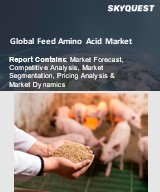
Report ID: SQMIG15E2437

Report ID:
SQMIG15E2437 |
Region:
Global |
Published Date: July, 2001
Pages:
247
|
Tables:
67 |
Figures:
75
Feed Amino Acid Market Driver
Consistent growth in animal output and consumption, as well as population growth, are two major driving factors
Consistent growth in animal output and consumption, as well as population growth, are two major driving factors that have been pushing global feed production demand in recent years. Increased commercialization of cattle rearing procedures, especially in developing nations, is another factor influencing feed production levels in recent times.
Increasing number of pets in households.
The growing number of adopting pets in households across many countries around the globe is another cardinal factor propelling the market . It has helped in increasing the pet foods, in turn driving the expansion of the market.
Increasing health awareness among the population.
Growing health awareness adopting a healthy lifestyle, together with an increase in the prevalence of diseases among people, has increased demand. The rise in the Pharmaceutical products and supplements required for the individual health is fuelling the growth of the market.
Feed Amino Acid Market Restraint
Alternate high protein sources and cost-efficiency products could restrain growth.
Our industry expert will work with you to provide you with customized data in a short amount of time.
REQUEST FREE CUSTOMIZATIONWant to customize this report? This report can be personalized according to your needs. Our analysts and industry experts will work directly with you to understand your requirements and provide you with customized data in a short amount of time. We offer $1000 worth of FREE customization at the time of purchase.

Report ID: SQMIG15E2437